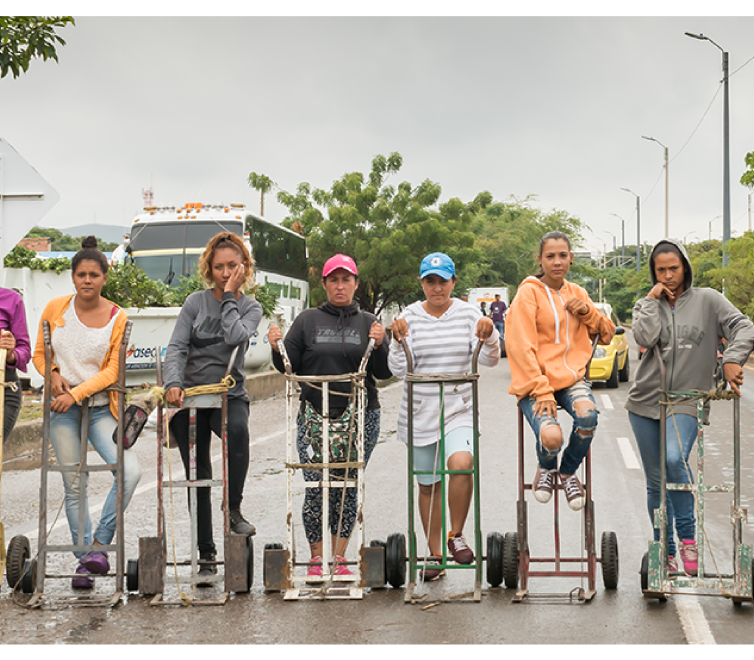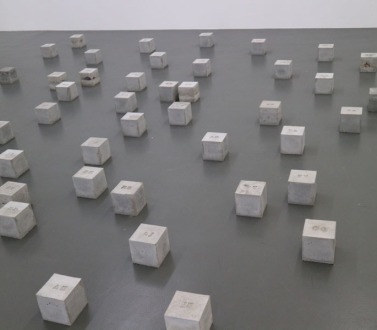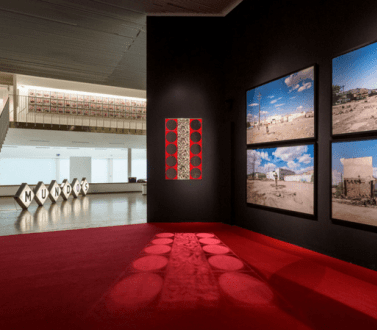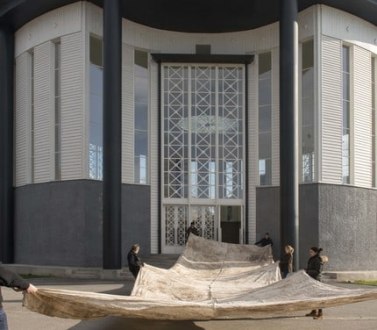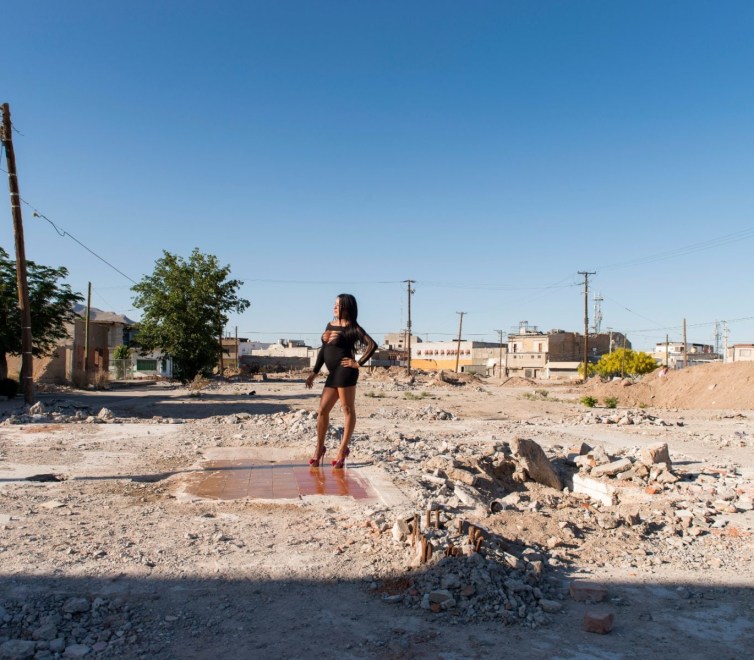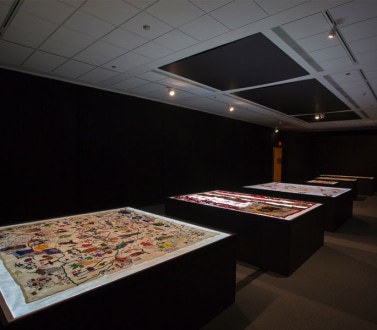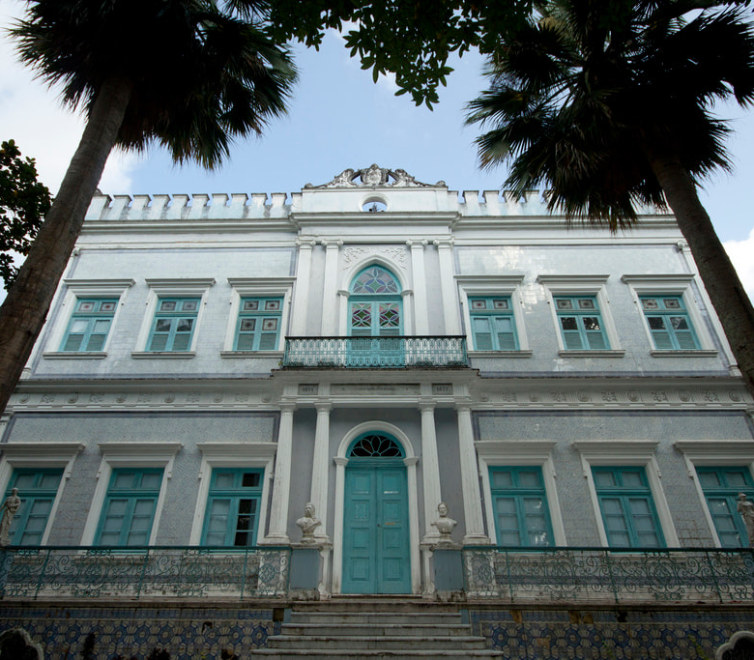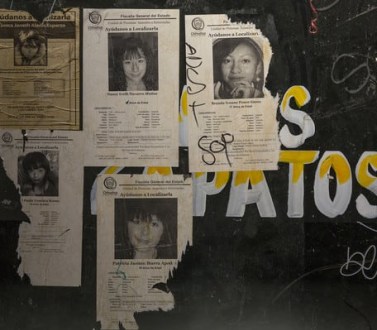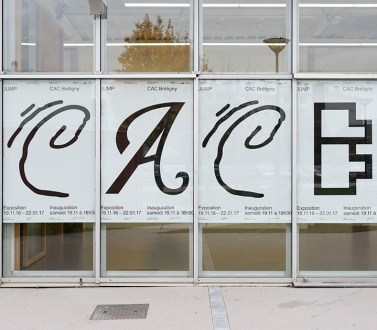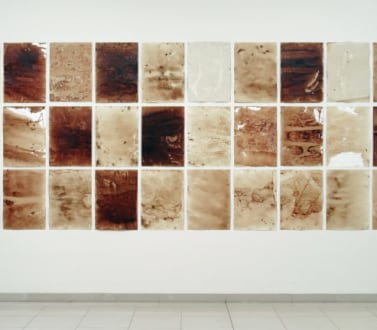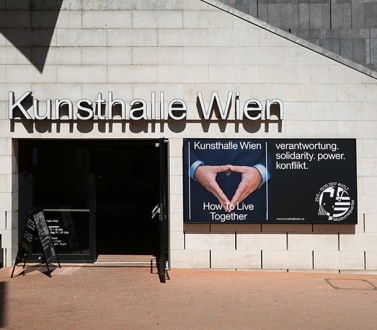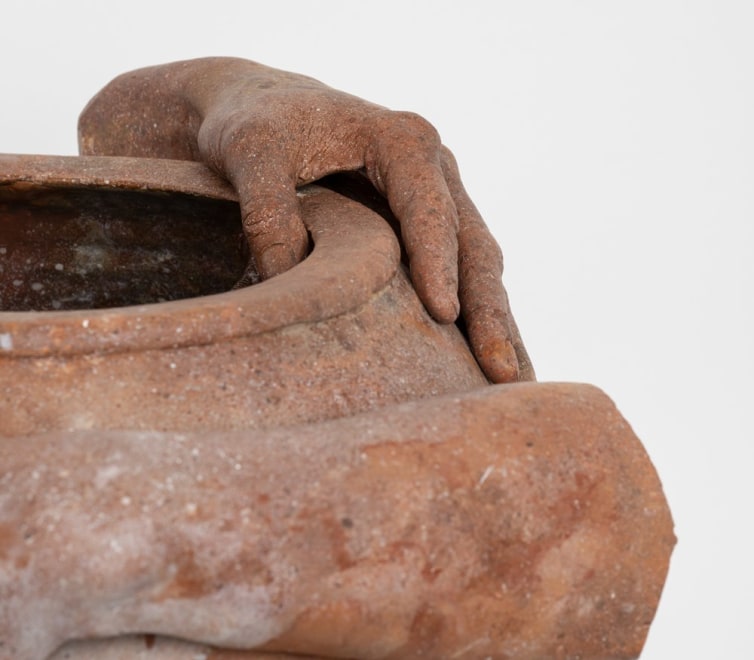
TERESA MARGOLLES
Mil Veces un Instante (A Thousand Times in an Instant), 2024
726 plaster imprints on steel armature
2468 x 4556 x 2110 in
6268.7 x 11572.2 x 5359.4 cm
JCG18096
TERESA MARGOLLES
Doce Crónicas (Febrero 2022), 2021-22
Ceramic pot made from clay collected from the Sierra Madre Occidental mountain range in Northern Mexico and painted with locally-sourced mineral pigments.
19 x 16 x 16 in.
48.3 x 40.6 x 40.6 cm
JCG12950.6
TERESA MARGOLLES
Línea Fronteriza, 2005 - ongoing
Pigmented inkjet color print on cotton paper
32 in. x 90 ft 9 in.
81 cm x 27 m 66 cm
Edition of 3 plus 1 artist’s proof
JCG14746
TERESA MARGOLLES
A TRAVÉS, 2007-2022
Phase 1: La entrega (The Remittance) - Garments obtained by exchange carried out across the five boroughs of New York City.
Phase 2: A Traves (Through) - Action that took place on the windows of 52 Walker St. on January 9, 2022. Photographic documentation.
Phase 3: Inclusión (Inclusion) - 24 cement blocks containing the t-shirts used for the action.
Two color photographs: 17 3/4 x 11 3/4 in (45 x 30 cm); 39 3/8 x 23 5/8 in (100 x 60 cm); Cement blocks each: 5 7/8 x 5 7/8 x 5 7/8 in (15 x 15 x 15 cm)
JCG13280
TERESA MARGOLLES
El agua del Río Bravo, 2021
32 hand-crafted air-conditioning units purchased from Mercado Los Herrajeros in the La Chaveña neighborhood of Ciudad Juárez, Mexico. Air conditioners are filled with water from the Río Bravo, the natural border between Ciudad Juárez and El Paso, Texas.
Each: 28 x 24 x 22 in (71.1 x 61 x 55.9 cm)
JCG12821
TERESA MARGOLLES
PM 2020, 2021
314 print reproductions on photographic paper of covers of the evening newspaper PM from Ciudad Juárez, Mexico, published in 2020
Each: 12 1/4 x 10 7/8 x 3/4 in. (31 x 27.5 x 2 cm) framed
Edition of 3 + 1 AP + 1 EC
JCG12110
TERESA MARGOLLES
PM 2020, 2021
Detail
TERESA MARGOLLES
Dos bancos, 2020
Two benches made from a mixture of cement and material sourced from the ground where the body fell of a person shot dead at the northern Mexican border
Each: 19 3/4 x 17 3/4 x 55 1/8 in.
50 x 45 x 140 cm
JCG11283
TERESA MARGOLLES
Dos bancos, 2020
Detail
TERESA MARGOLLES
El manto negro / The black shroud, 2020
1,600 burnished ceramic pieces hand-made by artisans in Mata Ortiz, Mexico
Dimensions variable
Each: Approx. 4 1/8 x 4 3/8 x 1 3/8 in.
10.5 x 11 x 3.5 cm
Edition of 3
JCG11131
TERESA MARGOLLES
Trocheras con piedras, 2019
Four photographs
Each: 47 1/4 x 78 3/4 in (120 x 200 cm) framed
Edition # TBC
TERESA MARGOLLES
Scarlett, Pista de baile del club 'La Cruda' (Scarlett, dance floor from the club 'La Cruda'), 2016
Pigmented inkjet print
Unframed: 47 1/4 x 70 7/8 in (120 x 180 cm)
Framed: 49 1/4 x 72 7/8 in (125 x 185 cm)
Edition 5/6 + 1 AP
JCG11042
TERESA MARGOLLES
La Huella, 2015
9 photographs
C-prints on Canson cotton paper
Each:
23 5/8 x 15 3/4 in
60 x 40 cm
Edition of 6
JCG11046
TERESA MARGOLLES
Limpieza (Cleaning), 2009
Performance
Exhibition floors were cleaned with a mixture of water and blood from people murdered in Mexico. The action took place at least once daily for the duration of the 2009 Venice Biennale.
TERESA MARGOLLES
Muro baleado (Culiacán), 2009
Fragment of a wall in front of which two police officers were killed in Culiacán, Sinaloa
83 7/8 x 155 7/8 x 5 3/4 in.
213 x 396 x 14.5 cm
TERESA MARGOLLES
Aproximación al lugar de los hechos (Proximity to the scene), 2020
Sound Installation: steel, 20 hot plates, dripping system and water extracted from sites where women were murdered in Sydney and its surrounding suburbs; red industrial curtains
20 steel plates: each 23 5/8 x 23 5/8 in. (60 x 60 cm)
Overall: 196 7/8 x 669 1/4 x 236 1/4 in. (500 x 1700 x 600 cm)
Installation view, NIRIN, 22nd Biennale of Sydney, National Art School, Sydney, Australia, August 7- September 26, 2020
Photo: Zan Wimberley
TERESA MARGOLLES
Super Speed / El Paso, Texas, 2020
Pigmented inkjet print
Box of 24 cartridges purchased from Walmart, Gateway Blvd, El Paso, TX
Unframed: 26 x 35 3/8 in. (66 x 90 cm)
Framed: 26 3/4 x 36 1/4 x 1 3/8 in. (67.9 x 92.1 x 3.5 cm)
Receipt, 2020
Facsimile of receipt from purchase from Walmart, Gateway Blvd, El Paso, TX
5 1/4 x 3 1/8 in.
13.3 x 8 cm
Edition of 3 plus 1 artist's proof
JCG11276
TERESA MARGOLLES
Pistas de Baile, 2016
16 pigmented inkjet prints
Each print:
Unframed: 15 3/4 x 23 5/8 in. (40 x 60 cm)
Framed: 16 1/4 x 24 3/8 in. (45 x 64.5 cm)
Edition of 6 plus 1 artist's print
JCG11016
TERESA MARGOLLES
Sillón tapizado frente a línea fronteriza / Upholstered armchair facing a borderline, 2019
Armchair recovered from the ruins of the Hotel Rex, a building in the historic center of Ciudad Juárez. The piece has been upholstered with fabric that previously absorbed fluids from a violent event that happened in the area. The cloth embedded inside the wall was dragged in that same location.
Chair: 33 3/4 x 31 1/2 x 35 in.
85.7 x 80 x 88.9 cm
Cloth: Dimensions variable
JCG10271
TERESA MARGOLLES
Sillón tapizado frente a línea fronteriza / Upholstered armchair facing a borderline, 2019
Detail
TERESA MARGOLLES
Trayecto — Fase 1. La entrega. Fase 2. A través. Fase 3. Inclusión (Trajectory— Phase 1. The Remittance. Phase 2. Through. Phase 3. Inclusion), 2018
Installation view, A new work by Teresa Margolles, Witte de With Center for Contemporary Art, Rotterdam, Netherlands, May 6- August 26, 2018
TERESA MARGOLLES
Trayecto — Fase 1. La entrega. Fase 2. A través. Fase 3. Inclusión (Trajectory— Phase 1. The Remittance. Phase 2. Through. Phase 3. Inclusion), 2018
Installation view, A new work by Teresa Margolles, Witte de With Center for Contemporary Art, Rotterdam, Netherlands, May 6- August 26, 2018
Photo: Kristien Daem
TERESA MARGOLLES
Trayecto — Fase 1. La entrega. Fase 2. A través. Fase 3. Inclusión (Trajectory— Phase 1. The Remittance. Phase 2. Through. Phase 3. Inclusion), 2018
Installation view, A new work by Teresa Margolles, Witte de With Center for Contemporary Art, Rotterdam, Netherlands, May 6- August 26, 2018
Photo: Kristien Daem
TERESA MARGOLLES
Trayecto — Fase 1. La entrega. Fase 2. A través. Fase 3. Inclusión (Trajectory— Phase 1. The Remittance. Phase 2. Through. Phase 3. Inclusion), 2018
Installation view, A new work by Teresa Margolles, Witte de With Center for Contemporary Art, Rotterdam, Netherlands, May 6- August 26, 2018
TERESA MARGOLLES
Trayecto — Fase 1. La entrega. Fase 2. A través. Fase 3. Inclusión (Trajectory— Phase 1. The Remittance. Phase 2. Through. Phase 3. Inclusion), 2018
Installation view, A new work by Teresa Margolles, Witte de With Center for Contemporary Art, Rotterdam, Netherlands, May 6- August 26, 2018
Photo: Kristien Daem
TERESA MARGOLLES
Trayecto — Fase 1. La entrega. Fase 2. A través. Fase 3. Inclusión (Trajectory— Phase 1. The Remittance. Phase 2. Through. Phase 3. Inclusion), 2018
Installation view, A new work by Teresa Margolles, Witte de With Center for Contemporary Art, Rotterdam, Netherlands, May 6- August 26, 2018
TERESA MARGOLLES
Trayecto — Fase 1. La entrega. Fase 2. A través. Fase 3. Inclusión (Trajectory— Phase 1. The Remittance. Phase 2. Through. Phase 3. Inclusion), 2018
Installation view, A new work by Teresa Margolles, Witte de With Center for Contemporary Art, Rotterdam, Netherlands, May 6- August 26, 2018
Photo: Kristien Daem
TERESA MARGOLLES
Muro Ciudad Juárez (Wall of Ciudad Juarez), 2010
Wall of concrete blocks from a public school in front of which a reckoning with 4 people involved in organized crime took place in Ciudad Juarez, Mexico.
69 1/4 x 496 1/8 x 5 7/8 in.
176 x 1260 x 15 cm
Exhibition view, May You Live In Interesting Times, 58th International Art Exhibition, Venice Biennale, Venice, Italy, May 11- November 24, 2019
Photo: Andrea Avezzù
TERESA MARGOLLES
Los Otros (The Others), 2018
Sound installation
Installation view, Teresa Margolles: Sutura, daadgalerie, Berlin, Germany, June 2- July 22, 2018
TERESA MARGOLLES
Installation view, Teresa Margolles,Ya Basta Hijos de Puta, Padiglione d'Arte Contemporanea, Milan, Italy, March 28- June 10, 2018
TERESA MARGOLLES
Sutura, Fabric from Guadalajara, 2011-2018
Intervention on fabric
Installation view, Teresa Margolles: Sutura, daadgalerie, Berlin, Germany, June 2- July 22, 2018
Photo: Jens Ziehe
TERESA MARGOLLES
Sutura, Fabric from Guadalajara, 2011-2018
Intervention on fabric
Installation view, Teresa Margolles: Sutura, daadgalerie, Berlin, Germany, June 2- July 22, 2018
TERESA MARGOLLES
La Gran América (The Great America), 2017
1400 bricks created by hand with the mud extracted from Rio Grande/ Rio Bravo riverbed, natural border that divides Ciudad Juárez (Mexico) and El Paso (Texas, USA)
Installation view, Teresa Margolles: Sutura, daadgalerie, Berlin, Germany, June 2- July 22, 2018
TERESA MARGOLLES
La Gran América (The Great America), 2017
Detail
TERESA MARGOLLES
Muro Ciudad Juárez (Wall of Ciudad Juarez), 2010
Wall of concrete blocks from a public school in front of which a reckoning with 4 people involved in organized crime took place in Ciudad Juarez, Mexico.
69 1/4 x 496 1/8 x 5 7/8 in.
176 x 1260 x 15 cm
Exhibition view, May You Live In Interesting Times, 58th International Art Exhibition, Venice Biennale, Venice, Italy, May 11- November 24, 2019
Photo: Andrea Avezzù
TERESA MARGOLLES
Vaporización (Vaporization), 2001- 2018
Vaporized water from the morgue that was used to wash the bodies of murder victims after the autopsy, 1-2 fog machines
Installation view, Teresa Margolles, Ya Basta Hijos de Puta, Padiglione d'Arte Contemporanea, Milan, Italy, March 28- June 10, 2018
TERESA MARGOLLES
Mundos (Worlds), 2016
Neon sign from a former bar in Ciudad Juárez, Mexico; loudspeaker
Six letters; each: 34 1/2 x 34 1/4 x 8 1/8 in. (87.5 x 87 x 20.5 cm)
Overall: 34 1/2 x 205 1/2 x 8 1/8 in. (87.5 x 522 x 20.5 cm)
Installation view, Teresa Margolles,Ya Basta Hijos de Puta, Padiglione d'Arte Contemporanea, Milan, Italy, March 28 - June 10, 2018
TERESA MARGOLLES
Karla, Hilario Reyes Gallegos, 2016
Black & white photographic print
95 x 60 in.
242 x 153 cm
Installation view, Teresa Margolles,Ya Basta Hijos de Puta, Padiglione d'Arte Contemporanea, Milan, Italy, March 28- June 10, 2018
TERESA MARGOLLES
Pesquisas (Inquiries), 2016
30 color prints of photographs of street signs showing missing women that cover the walls of Ciudad Juarez, Mexico from the nineties until today
Each: 39 3/8 x 27 1/2 in.
100 x 70 cm
Total: 79 x 277.4 in.
200 x 705 cm
Installation view, Teresa Margolles: Mundos, Musée d’art contemporain de Montréal, Canada, February 16- May 14, 2017
TERESA MARGOLLES
Pesquisas (Inquiries), 2016
Installation view, Teresa Margolles: Mundos, Musée d’art contemporain de Montréal, Canada, February 16- May 14, 2017
TERESA MARGOLLES
Mesa y dos bancos, 2013
Made from a mixture of cement and material taken from the ground, on which there lay the body
of a person murdered at the northern Mexican border
Table: 33.5 x 31.5 x 78 in.
85 x 80 x 200 cm
Benches: 19.7 x 17.7 x 55 in.
50 x 45 x 140 cm each
Installation view, Teresa Margolles, Ya Basta Hijos de Puta, Padiglione d'Arte Contemporanea, Milan, Italy, March 28- June 10, 2018
TERESA MARGOLLES
57 cuerpos (57 Bodies), 2010
Synthetic thread, cotton thread, blood and bodily fluids
Length: 862 1/4 in. (2190 cm)
Overall display dimensions variable
Installation view, Teresa Margolles, Ya Basta Hijos de Puta, Padiglione d'Arte Contemporanea, Milan, Italy, March 28- June 10, 2018
JCG11375
TERESA MARGOLLES
57 cuerpos (57 Bodies), 2010
Synthetic thread, cotton thread, blood and bodily fluids
Length: 862 1/4 in. (2190 cm)
Overall display dimensions variable
Installation view, Teresa Margolles, Ya Basta Hijos de Puta, Padiglione d'Arte Contemporanea, Milan, Italy, March 28- June 10, 2018
JCG11375
TERESA MARGOLLES
36 cuerpos (36 Bodies), 2010
Synthetic thread, cotton thread, blood and bodily fluids
Length: 862 1/4 in. (2190 cm)
Overall display dimensions variable
Installation view, Teresa Margolles: Mundos, Musée d’art contemporain de Montréal, Canada, February 16- May 14, 2017
JCG11375
TERESA MARGOLLES
36 cuerpos (36 Bodies), 2010
Detail
Installation view, Teresa Margolles: Mundos, Musée d’art contemporain de Montréal, Canada, February 16- May 14, 2017
TERESA MARGOLLES
La Promesa (The Promise), 2012-2017
22 tons of rubble, performance
Remains of a demolished house from Ciudad Juárez, Mexico
Installation view, Teresa Margolles: Mundos, Musée d’art contemporain de Montréal, Canada, February 16- May 14, 2017
TERESA MARGOLLES
La Promesa (The Promise), 2012-2017
22 tons of rubble, performance
Detail
Installation view, Teresa Margolles: Mundos, Musée d’art contemporain de Montréal, Canada, February 16- May 14, 2017
TERESA MARGOLLES
Wila Patjharu / Sobre la Sangre, 2017
Embroidered canvas saturated with the blood of ten women murdered in La Paz, Bolivia
Installation view, Teresa Margolles: Sobre la sangre, Tenuta Dello Scompiglio, Vorno, Italy, March 25- September 16, 2017
TERESA MARGOLLES
Installation view, Teresa Margolles: We Have a Common Thread, Colby Museum, Waterville, ME, September 13 - December 11, 2016
Photos: Jason Paige Smith
TERESA MARGOLLES
Installation view, Teresa Margolles: We Have a Common Thread, Colby Museum, Waterville, ME, September 13 - December 11, 2016
Photos: Jason Paige Smith
TERESA MARGOLLES
La Sombra (The Shade), 2016
Concrete structure built with water used for marking the spots where bodies of murder victims had laid in Los Angeles, US
Installation view, Teresa Margolles, Current:LA Water, Public Art Biennial, Los Angeles, CA, July 16- August 14, 2016
TERESA MARGOLLES
La Sombra (The Shade), 2016
Concrete structure built with water used for marking the spots where bodies of murder victims had laid in Los Angeles, CA
Installation view, Teresa Margolles, Current:LA Water, Public Art Biennial, Los Angeles, CA, July 16- August 14, 2016
TERESA MARGOLLES
La Sombra (The Shade), 2016
Concrete structure built with water used for marking the spots where bodies of murder victims had laid in Los Angeles, US
Installation view, Teresa Margolles, Current:LA Water, Public Art Biennial, Los Angeles, CA, July 16- August 14, 2016
TERESA MARGOLLES
Karla, Hilario Reyes Gallegos, 2016
Karla, Hilario Reyes Gallegos, transsexual sex worker beaten to death in December 2015, in Ciudad Juarez, Mexico.
Her murder is still unpunished.
Color print on gloss paper
30 7/8 x 47 1/4 in.
78.4 x 120 cm
TERESA MARGOLLES
Paloma, Pista de Baile de la Discoteca 'Virginia's' (Paloma, dance floor from the club 'Virginia's'), 2016
Transgender sex worker standing on the dance floor of a demolished club in Ciudad Juárez, Mexico
Pigmented inkjet print on cotton paper
49 1/4 x 72 7/8 in.
125 x 185 cm
TERESA MARGOLLES
Marlene, Pista de Baile del club 'Mona Lisa' (Marlene, dance floor from the club 'Mona Lisa'), 2016
Transgender sex worker standing on the ruins of the dance floor of a demolished nightclub in Ciudad Juárez, Mexico
Color print on cotton paper
49 1/4 x 72 7/8 in.
125 x 185.1 cm
TERESA MARGOLLES
Vanessa, Pista de baile de la discoteca 'Eduardo's' (Vanessa, dance floor from the club 'Eduardo's'), 2016
Transgender sex worker standing on the dance floor of a demolished club in Ciudad Juárez, Mexico
Color print on cotton paper
49 1/4 x 72 7/8 in.
125 x 185.1 cm
TERESA MARGOLLES
Andrea, Pista de Baile del la Discoteca 'La Madelón' (Andrea, dance floor from the club 'La Madelón'), 2016
Transgender sex worker standing on the dance floor of a demolished club in Ciudad Juárez, Mexico
Color print on cotton paper
17 3/4 x 25 3/8 in.
125 x 185.1 cm
TERESA MARGOLLES
Pista de Baile del club "Apache" (Dance floor of the club "Apache"), 2016
Transgender sex worker standing on the dance floor of a demolished club in Ciudad Juárez, Mexico
Color print on cotton paper
49 1/4 x 72 7/8 in.
125 x 185.1 cm
TERESA MARGOLLES
Sansara, Pista de Baile del club 'Irma's' (Sansara, dance floor from the club 'Irma's'), 2016
Transgender sex worker standing on the ruins of the dance floor of a demolished nightclub in Ciudad Juárez, Mexico
Color print on cotton paper
49 1/4 x 72 7/8 in.
125 x 185.1 cm
TERESA MARGOLLES
Dylegued (Entierro) [Dylegued (Burial)], 2013
Mola on fabric permeated with blood from the body of a woman assassinated in Panama City, Panama
Created with the participation of the Rosano family, of Kuna descent, in memory of Jadeth Rosano Lopez, a seventeen-year-old teenager who was assassinated, Panama City, Panama
39 3/8 x 90 1/2 in.
100 x 229.9 cm
Installation view, Teresa Margolles: We Have a Common Thread, Neuberger Museum of Art, Purchase, NY, July 12- October 11, 2015
TERESA MARGOLLES
La búsqueda, 2014
Sound installation
Intervention with sound frequency on glass panels transported from the historical center of Ciudad Juárez. The audio was recorded from the train that divides the city, and transformed into low frequencies.
2 parts: 112.2 x 59.3 x 47.2 in. (285 x 150.5 x 120 cm); 112.2 x 40.7 x 47.2 in. (285 x 103.5 x 120 cm)
Installation view, Teresa Margolles: La búsqueda, Migros Museum für Gegenwartskunst, Zurich, Switzerland, May 24- August 17, 2014
Photo: FBM Studio
TERESA MARGOLLES
La búsqueda, 2014
Sound installation
Intervention with sound frequency on glass panels transported from the historical center of Ciudad Juárez. The audio was recorded from the train that divides the city, and transformed into low frequencies.
2 parts: 112.2 x 59.3 x 47.2 in. (285 x 150.5 x 120 cm); 112.2 x 40.7 x 47.2 in. (285 x 103.5 x 120 cm)
Installation view, Teresa Margolles: La búsqueda, Migros Museum für Gegenwartskunst, Zurich, Switzerland, May 24- August 17, 2014
Photo: FBM Studio
TERESA MARGOLLES
La búsqueda, 2014
Sound installation
Intervention with sound frequency on glass panels transported from the historical center of Ciudad Juárez. The audio was recorded from the train that divides the city, and transformed into low frequencies.
2 parts: 112.2 x 59.3 x 47.2 in. (285 x 150.5 x 120 cm); 112.2 x 40.7 x 47.2 in. (285 x 103.5 x 120 cm)
Installation view, Teresa Margolles: La búsqueda, Migros Museum für Gegenwartskunst, Zurich, Switzerland, May 24- August 17, 2014
Photo: FBM Studio
TERESA MARGOLLES
Mesa y dos bancos, 2013
Made from a mixture of cement and material taken from the ground, on which there lay the body
of a person murdered at the northern Mexican border
Table: 33 x 31.5 x 78.7 in. (85 x 80 x 200 cm)
benches: 19.7 x 17.7 x 55.1 in. (50 x 45 x 140 cm)
Installation view, Teresa Margolles: La búsqueda, Migros Museum für Gegenwartskunst, Zurich, Switzerland, May 24- August 17, 2014
Photo: FBM Studio
TERESA MARGOLLES
PM 2010, 2012
313 covers of the Mexican daily tabloid from 2010, the most violent year in the entire history of drug trafficking in Mexico
Installation view, Teresa Margolles, El Testigo, CA2M Centro de Arte Dos de Mayo, Madrid, Spain, February 18- May 25, 2014
JCG11245
TERESA MARGOLLES
PM 2010, 2012
313 covers of the Mexican daily tabloid from 2010, the most violent year in the entire history of drug trafficking in Mexico
Installation view, Teresa Margolles, El Testigo, CA2M Centro de Arte Dos de Mayo, Madrid, Spain, February 18- May 25, 2014
JCG11245
TERESA MARGOLLES
Esta finca no será demolida, 2011-2014
Installation view, Teresa Margolles, El Testigo, CA2M Centro de Arte Dos de Mayo, Madrid, Spain, February 18- May 25, 2014
TERESA MARGOLLES
¿Cómo salimos? (How do we leave?), 2010
Two-channel video installation (color, sound)
2.01 minute, loop
Installation view, Teresa Margolles, El Testigo, CA2M Centro de Arte Dos de Mayo, Madrid, Spain, February 18- May 25, 2014
TERESA MARGOLLES
A través... (Through...), 2011
Glass panels coated in sweat from t-shirts worn over a period of time
Installation view, Teresa Margolles, An Oasis of Horror in a Desert of Boredom, Visual Contemporary Art Carlow, Ireland, October 6, 2012- January 6, 2013
TERESA MARGOLLES
Sonidos de la Muerte (Sounds of Death), 2008
Sound installation with recordings taken in places where murdered women were found
Dimensions variable
Installation view, Teresa Margolles, An Oasis of Horror in a Desert of Boredom, Visual Contemporary Art Carlow, Ireland, October 6, 2012- January 6, 2013
TERESA MARGOLLES
Aire (Air), 2003
Installation view, Teresa Margolles, Invisible: Art about the Unseen 1957-2012, Hayward Gallery, Southbank Centre, London, UK, June 12- August 5, 2012
Photo: Mark Blower
TERESA MARGOLLES
Bandera I (Flag I), 2009
Fabric, blood, earth and other substances
117 3/8 x 74 1/8 in.
298 x 188 cm
TERESA MARGOLLES
Ya basta hijos de puta, 2010
Text carved in the wall
Message written on the body of a decapitated woman found in Tijuana
Installation view, Teresa Margolles: Frontera, MUSEION, Bolzano, Italy, May 28- August 21, 2011
Photo: Augustin Ochsenreiter
Installation view, Teresa Margolles: Frontera, MUSEION Bozen/Bolzano, Italy, May 28 - August 21, 2011
Photo: Augustin Ochsenreiter
TERESA MARGOLLES
Untitled, 2011
Installation view, Teresa Margolles, VIA/Stage 2, Resnick North Lawn, Los Angeles County Museum of Art, presented in collaboration with the Los Angeles Nomadic Division, October 31, 2010- August 28, 2011
TERESA MARGOLLES
Frontera, 2010
Installation, 40 cloths soaked with soil and body fluids from different cities in north-western Mexico
Installation view, Teresa Margolles: Frontera, Kunsthalle Fridericianum, Kassel, Germany, December 4, 2010- February 20, 2011
Photo: Nils Klinger
TERESA MARGOLLES
Herida, 2010
An incision in the wall that is filled with the body fat of murdered people.
Installation view, Teresa Margolles: Frontera, Kunsthalle Fridericianum, Kassel, Germany, December 4, 2010 - February 20, 2011
Photo: Nils Klinger
TERESA MARGOLLES
Plancha, 2010
Water used to wash corpses after autopsy, heated steel plates
Photo: Nils Klinger
TERESA MARGOLLES
Corporización de la ausencia, 2010
Two-channel video installation, sound
Photo: Nils Klinger
TERESA MARGOLLES
Cómo Salimos?, 2010
Two-channel video installation, sound
Photo: Nils Klinger
TERESA MARGOLLES
Joyas, 2007
These pieces of jewelry consist of glass shards that Teresa Margolles picked from the street after a gang gunfight. A jeweler from Culiacan incorporated the glass into jewelry designed to resemble the jewelry gang leaders wear. The precious jewels are replaced by shards of glass from crime scenes.
Photo: Nils Klinger
TERESA MARGOLLES
Joyas, 2007
These pieces of jewelry consist of glass shards that Teresa Margolles picked from the street after a gang gunfight. A jeweler from Culiacan incorporated the glass into jewelry designed to resemble the jewelry gang leaders wear. The precious jewels are replaced by shards of glass from crime scenes.
Photo: Nils Klinger
TERESA MARGOLLES
Joyas, 2007
These pieces of jewelry consist of glass shards that Teresa Margolles picked from the street after a gang gunfight. A jeweler from Culiacan incorporated the glass into jewelry designed to resemble the jewelry gang leaders wear. The precious jewels are replaced by shards of glass from crime scenes.
Photo: Nils Klinger
TERESA MARGOLLES
Cubo, 2010
One ton of scrap rebar from razed buildings on Calle Marsical, a street in the old section of Ciudad Juárez, at the border to El Paso, Texas.
Photo: Nils Klinger
TERESA MARGOLLES
Bandera (Flag), 2009
Fabric dyed with blood collected from executions on the north border of Mexico
Installation view, Teresa Margolles, What Else Could We Talk About?, 53rd International Art Exhibition of the Venice Biennale, exterior of the Rota Ivancich Palace, Venice, Italy, June 7- November 22, 2009
TERESA MARGOLLES
Cleaning, 2009
Cleaning of the exhibition floors with a mixture of water and blood from murdered people in Mexico. The action took place at least once a day during the extent of the Venice Biennial.
Installation view, Teresa Margolles, What Else Could We Talk About?, 53rd International Art Exhibition of the Venice Biennale, Venice, Italy, June 7- November 22, 2009
TERESA MARGOLLES
Cleaning, 2009
Cleaning of the exhibition floors with a mixture of water and blood from murdered people in Mexico. The action took place at least once a day during the extent of the Venice Biennial.
Installation view, Teresa Margolles, What Else Could We Talk About?, 53rd International Art Exhibition of the Venice Biennale, Venice, Italy, June 7- November 22, 2009
TERESA MARGOLLES
Cleaning, 2009
Cleaning of the exhibition floors with a mixture of water and blood from murdered people in Mexico. The action took place at least once a day during the extent of the Venice Biennial.
Installation view, Teresa Margolles, What Else Could We Talk About?, 53rd International Art Exhibition of the Venice Biennale, Venice, Italy, June 7- November 22, 2009
TERESA MARGOLLES
Embassy, 2009
Intervention to the United States pavilion at the Giardini of Venice with fabrics with blood of executed people in the north border of Mexico
Installation view, Teresa Margolles, What Else Could We Talk About?, 53rd International Art Exhibition of the Venice Biennale, Venice, Italy, June 7- November 22, 2009
TERESA MARGOLLES
Dragged Cloth, 2009
Public action in Lido Beach, Venice, done with fabric impregnated with blood collected from execution sites in Mexico
Installation view, Teresa Margolles, What Else Could We Talk About?, 53rd International Art Exhibition of the Venice Biennale, Venice, Italy, June 7- November 22, 2009
TERESA MARGOLLES
Cards to cut up cocaine, 2009
Multiple of ten thousand copies to be distributed during the opening days of the 53rd Venice Biennial
Installation view, Teresa Margolles, What Else Could We Talk About?, 53rd International Art Exhibition of the Venice Biennale, Venice, Italy, June 7- November 22, 2009
TERESA MARGOLLES
Cards to cut up cocaine, 2009
Multiple of ten thousand copies to be distributed during the opening days of the 53rd Venice Biennial
Installation view, Teresa Margolles, What Else Could We Talk About?, 53rd International Art Exhibition of the Venice Biennale, Venice, Italy, June 7- November 22, 2009
TERESA MARGOLLES
Embroidery, 2009
Joint activities in the city of Venice embroidering with gold threads the fabrics collected from execution sites in the north border of Mexico
Installation view, Teresa Margolles, What Else Could We Talk About?, 53rd International Art Exhibition of the Venice Biennale, Venice, Italy, June 7- November 22, 2009
TERESA MARGOLLES
Groundwork for Recovered Blood, 2009
Series of actions by volunteers in the places where people have been executed in the north of Mexico
Installation view, Teresa Margolles, What Else Could We Talk About?, 53rd International Art Exhibition of the Venice Biennale, Venice, Italy, June 7- November 22, 2009
TERESA MARGOLLES
Groundwork for Recovered Blood, 2009
Series of actions by volunteers in the places where people have been executed in the north of Mexico
Installation view, Teresa Margolles, What Else Could We Talk About?, 53rd International Art Exhibition of the Venice Biennale, Venice, Italy, June 7- November 22, 2009
TERESA MARGOLLES
Recovered Blood, 2009
Installation of mud-impregnated fabrics that were used to clean places where bodies of murdered persons were found in Mexico. The transfer of this material to Venice was performed through the remoisturizing of these fabrics.
Installation view, Teresa Margolles, What Else Could We Talk About?, 53rd International Art Exhibition of the Venice Biennale, Venice, Italy, June 7- November 22, 2009
TERESA MARGOLLES
Narcomessages, 2009
Fabric impregnated with blood gathered from the places where murders took place embroidered with gold threads. The fabrics were progressively embroidered during the Venice Biennial
Installation view, Teresa Margolles, What Else Could We Talk About?, 53rd International Art Exhibition of the Venice Biennale, Venice, Italy, June 7- November 22, 2009
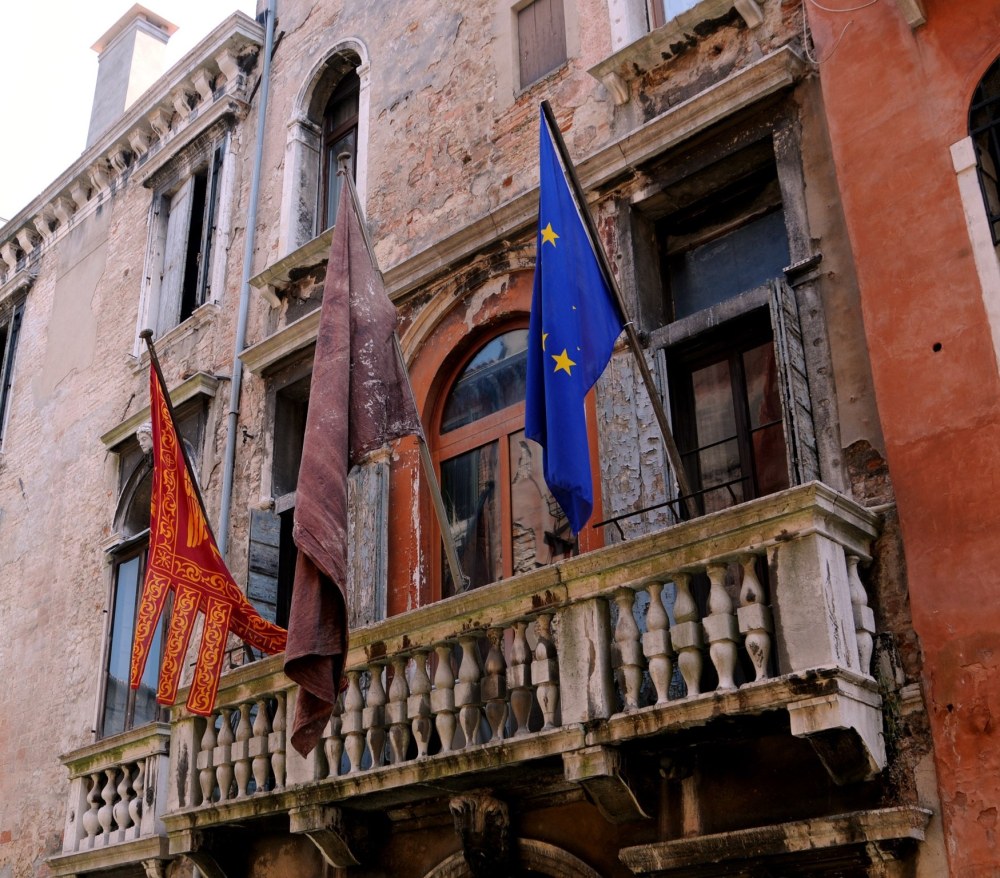
Teresa Margolles, Bandera / Flag I, 2009. Installation view, What Else Could We Talk About?, 53rd Venice Biennale, Italy, 2009.
For over twenty-five years, Teresa Margolles (b. 1963, Culiacán, Sinaloa, Mexico) has investigated the social and aesthetic dimensions of conflict, creating sculptural installations, photographs, films, and performances imbued with material traces of death. The artist’s work most often incorporates physical remnants of violent crimes resulting from political corruption and social exclusion—blood-stained sheets, glass shards from shattered windshields, bullet-ridden walls, or used surgical threads—whose victims are otherwise rendered invisible. Tapping into the restrained sensibilities of conceptualism and minimalism, Margolles inserts post-mortem matter typically obscured from public consciousness into the architectures of civic and cultural institutions. Filling a white-cube gallery space with a dense fog of vaporized water previously used to wash corpses, for example, or mounting a flag onto the facade of the Venice Biennale’s Palazzo Rota-Ivancich splattered with blood from homicides near the Mexico-U.S. border, Margolles transgresses normative boundaries to command attention and invoke accountability.
Trained as a forensic pathologist, Teresa Margolles was employed in the early 1990’s as a mortician in Mexico City. Her work during that time, which she produced as a member of the artist collective SEMEFO and also independently, stemmed from her proximity to nameless victims of drug-trafficking violence whose unidentifiable bodies passed in numbers through the morgue, largely regarded as “collateral damage.” Maintaining that there is much to be learned about society from the unseen treatment of cadavers within institutional margins, during this period Margolles created public performances, sculptural objects, and photographic series making the “life of the corpse” radically visible in public space. Branching out from the context of Mexico to other sites of conflict in Latin America and overseas, her strategy continues to expose the social and economic structures that enable such atrocities and exclude them from the social imaginary.
Margolles engages in fieldwork-driven artmaking in the streets of border cities in northern Mexico, such as Ciudad Juárez, whose location in economic relationship to the United States has ushered in decades of conflict due to organized crime. Working closely with communities who are precluded from access to systems of social care, Margolles explores the relationship between violence and marginality, especially in light of gender. Her methodical research develops into object-based interventions: photographs of trans sex workers, many of whom are now dead, standing in the ruins of demolished nightclubs where they once worked; or posters with the faces of missing women affixed to glass panels that rattle to the sound of a train carrying manufactured goods from Juárez to El Paso. Exhibited internationally, her works underscore the influences of global trade and economic policy on conflict in Latin America.
In response to the 975 homicides that took place in Los Angeles, U.S. between January 2015 and July 2016, Margolles poured water onto the ground in nearly one hundred locations where lives were lost due to violent crime. The water was then collected into hundreds of meticulously-labeled bottles and ultimately used to mix concrete poured to form a monumental sculpture that cast shade in Echo Park.
Teresa Margolles has exhibited extensively for more than two decades, both in Latin America and abroad. Recent solo exhibitions include En la Herida, Kunsthalle Krems, Krems, Austria (2019); You fall in line or they put you in line (Te alineas o te alineamos), BPS22 Musée d'art de la Province de Hainaut, Charleroi, Belgium (2019); LA CARNE MUERTA NUNCA SE ABRIGA, Museo de la Solidaridad Salvador Allende, Santiago, Chile (2019); Estorbo, Museo de Arte Moderno de Bogotá, Colombia (2019); Sutura, Francuski Paviljon, Zagreb, Croatia, which traveled to daadgalerie, Berlin, Germany (2018); A new work by Teresa Margolles, Witte de With, Rotterdam, Netherlands (2018); Ya Basta Hijos de Puta, PAC Padiglione d’Arte Contemporanea, Milan, Italy (2018); Mundos, Musée d’Art Contemporain de Montréal, Canada (2017); Teresa Margolles: 45 Cuerpos, Museo de la Ciudad de Querétaro, Mexico (2016); We Have a Common Thread, Neuberger Museum of Art, Purchase, NY, which traveled to Colby Museum of Art, Waterville, ME and Rubin Gallery, The University of Texas at El Paso, TX (2015); Enquanto for Necessário (As Long as it is Needed), Fundação Joaquim Nabuco, Recife, Brazil (2014); El Testigo, Centro de Arte Dos de Mayo, Madrid, Spain (2014); La Promesa, Museo Universitario de Arte Contemporáneo (MUAC), Mexico City, Mexico (2012); and Frontera, Kunsthalle Fridericianum, Kassel, Germany, which traveled to Museion, Bolzano, Italy (2010).
Margolles has been the recipient of numerous awards, including the Artes Mundi Prize and the Prince Claus Award for Culture and Development in 2012. She represented Mexico at the 53rd Venice Biennale in 2009 with What Else Could We Talk About? and received a special jury mention for her work at the 58th Venice Biennale in 2019. Margolles has participated in many other biennials including Imagined Communities, 21st Sesc_Videobrasil Contemporary Art Biennial, São Paulo, Brazil (2019); Eldorado, 5th lille3000, Lille, France (2019); Frestas Trienal de Artes: Entre Pós-Verdades e Acontecimentos, Sesc Sorocaba, São Paulo, Brasil (2017); Woman Biennial - Biennale Donna: SILENCIO VIVO. Artists from Latin America, PAC Padiglione d'Arte Contemporanea, Ferrara, Italy (2016); IV Trienal Poli/Gráfica, Antiguo Arsenal de la Marina Española, San Juan, Puerto Rico (2015); 7th Berlin Biennale, Berlin, Germany (2012); Manifesta 11: What People Do For Money, Zurich, Switzerland (2011); The Living Currency, 5th Berlin Biennial, Berlin, Germany (2010); and The Rest of Now, Manifesta 7, Ex-Alumix, Bolzano, Italy (2008).
Her work is held in the permanent collections of major institutions worldwide, including Castello di Rivoli Museo d’Arte Contemporanea, Torino, Italy; Centre Georges Pompidou, Paris, France; Colección Centro de Arte Dos de Mayo, Mostoles, Madrid, Spain; Colección Fundación ARCO, Madrid, Spain; Des Moines Art Center, Des Moines, IA; Fotomuseum Winterthur, Switzerland; FRAC Lorraine, Metz, France; Hirshhorn Museum and Sculpture Garden, Washington, D.C.; Kunsthaus Zürich, Switzerland; Colección Jumex, Mexico City, Mexico; Musée d’Art Contemporain, Montreal, Canada; Museion Museo d’arte moderna e contemporanea, Bolzano, Italy; Museo Universitario Arte Contemporáneo, Mexico City, Mexico; Museo Tamayo Arte Contemporáneo, Mexico City, Mexico; Museum für Moderne Kunst, Frankfurt, Germany; Museum of Modern Art in Warsaw, Poland; National Gallery of Canada, Ottawa, Canada; Neue Nationalgalerie, Berlin, Germany; Pérez Art Museum, Miami, FL; Philbrook Museum of Art, Tulsa, OK; Phoenix Art Museum, Phoenix, AZ; Tate Modern, London, UK and The Museum of Fine Arts, Houston, TX.
For over twenty-five years, Teresa Margolles (b. 1963, Culiacán, Sinaloa, Mexico) has investigated the social and aesthetic dimensions of conflict, creating sculptural installations, photographs, films, and performances imbued with material traces of death. The artist’s work most often incorporates physical remnants of violent crimes resulting from political corruption and social exclusion—blood-stained sheets, glass shards from shattered windshields, bullet-ridden walls, or used surgical threads—whose victims are otherwise rendered invisible.
